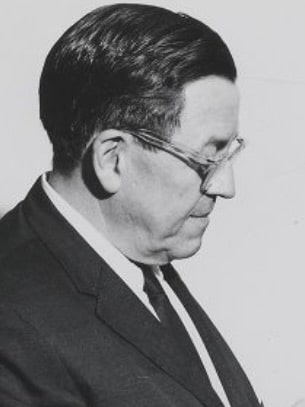Maurice David Sachs

Maurice David Sachs (1909-1987) was an American radiologist.
Maurice David Sachs was an American radiologist and a pioneering medical leader dedicated to equitable healthcare and community engagement in mid-20th century Cleveland. He was born in Hartford, Connecticut, on November 20, 1909, and received his medical education at Long Island University and the University of Bern in Switzerland. Sachs served as a professor of radiology at Case Western Reserve University Medical School and held leadership roles across several major institutions.
Following World War II, Sachs became a formative figure in the development of Forest City Hospital, a groundbreaking institution in Cleveland founded to provide inclusive care and professional opportunities across racial lines. As the hospital’s first radiology chief from its planning in 1955 through its eventual operations, Sachs was instrumental in shaping both its clinical and philosophical foundation.
He also helped establish and lead the first commercial CAT scanner unit in Ohio, influencing regional cancer detection and diagnostics. Sachs was known for his ethical convictions, often resisting pressures to conform, and remained committed to justice in medicine.
Biographical timeline
- 1909 – Born November 20 in Hartford, Connecticut.
- 1930s – Studied medicine at Long Island University and the University of Bern, Switzerland.
- 1940 – Co-authored landmark study with Harold Arthur Hill (1901–1978) on 119 cases of anterior shoulder dislocation, describing the cortical impaction fracture later termed the Hill-Sachs lesion.
- 1940s – Served in the U.S. Army Medical Corps, stationed at Letterman Hospital, San Francisco.
- 1941 – Married Dr Frances Ruth Langoe in San Francisco.
- Post-WWII – Worked at Case Western Reserve University; became professor and head of radiology.
- 1955 – Invited by Dr. H. Middleton Lambright Sr. to become founding chair of radiology at Forest City Hospital.
- 1956 – Founded a private radiology group in Cleveland
- 1957 – Forest City Hospital opened; Sachs leads Department of Radiology.
- 1960s–1970s – Helped install and lead CAT scanning initiatives in Cleveland.
- 1976 – Retired to Carmel Highlands, CA.
- 1987 – Died December 17 at Stanford University Hospital, Palo Alto, CA.
Medical Eponyms
Hill-Sachs defect (1940)
Cortical depression of posterolateral head of the humerus related to impaction of the humeral head with inferior glenoid in anterior shoulder dislocation. Often associated with a Bankart lesion of the glenoid.
The resultant lesion predisposes the shoulder joint to recurrent dislocations, the lesion is larger in relation to the number of dislocations
In 1940, Hill and Sachs published a report of 119 shoulder dislocation cases. They determined that the cortical depression in the posterolateral head of the humerus was related to impaction of the humeral head against the inferior glenoid in anterior shoulder dislocation.
The defect is located posterior and medial to the greater tuberosity on the posterolateral aspect of the articulating surface of the humeral head. The groove is navicular or wedge-shaped and its average measurements are 2.5 cm. in length (cephalocaudad), 1.5 cm. in width, and 0.75 cm. in depth. The defect is demarcated from the surrounding normal bone by sharp or vertically projecting walls, which in the larger defects stand at a right-angle to each other
Hall, Sachs 1940: 690
A more widespread knowledge regarding the possibility of the existence of these lesions should lead to better results in the treatment of shoulder dislocations and disabilities
Hall, Sachs 1940: 700

Major Publications
- Hill HA, Sachs MD. The grooved defect of the humeral head: a frequently unrecognized complication of dislocations of the shoulder joint. Radiology. 1940; 35(6): 690–700
- Partington PF, Sachs MD. Routine use of operative cholangiography. Surg Gynecol Obstet. 1948; 87(3): 299-307.
- Sachs MD, McGAW WH, Rizzo RP. Studies in the scope of pneumoarthrography of the knee as a diagnostic aid. Radiology. 1950; 54(1): 10-32
- Sachs MD. Visualization of the common duct during cholecystography; its significance. Am J Roentgenol Radium Ther Nucl Med. 1953; 69(5): 745-68
- Wolkin J, Sachs MD, Hoke GH. Comparative studies of discography and myelography. Radiology. 1955; 64(5): 704-713.
- Sachs MD, Partington PF. Cholangiographic diagnosis of pancreatitis. Am J Roentgenol Radium Ther Nucl Med. 1956; 76(1): 32-38.
- Sachs MD. Practical observations of the biliary tract with operative cholangiography and cholografin. J Int Coll Surg. 1957; 27(6): 681-689
- Sachs MD, Partington PF. The distended gallbladder; the value of a fat meal in cholecystography. Am J Roentgenol Radium Ther Nucl Med. 1960; 83: 835-842
- Ross RJ, Sachs MD. Triplication of the gallbladder. Am J Roentgenol Radium Ther Nucl Med. 1968; 104(3): 656-661
References
Biography
- Obituary: Maurice D. Sachs. Carmel Pine Cone. February 4, 1988
- Headstone. Findagrave.com
- Twentieth century medicine in Cleveland: an oral history interview with U. G. Mason, Melbahu Mason, and Dr. Frances R. Sachs and part 2
- Portrait: Dr. Maurice Sachs and Dr. M. H. Lambright Jr.
Eponymous terms
- Somford MP, Nieuwe Weme RA, van Dijk CN, IJpma FF, Eygendaal D. Are eponyms used correctly or not? A literature review with a focus on shoulder and elbow surgery. Evid Based Med. 2016; 21(5): 163-71
- Somford MP, Van der Linde JA, Wiegerinck JI, Hoornenborg D, Van den Bekerom MPJ, Van Deurzen DFP. Eponymous terms in anterior shoulder stabilization surgery. Orthop Traumatol Surg Res. 2017; 103(8): 1257-1263.
Eponym
the person behind the name
BA MA (Oxon) MBChB (Edin) FACEM FFSEM. Emergency physician, Sir Charles Gairdner Hospital. Passion for rugby; medical history; medical education; and asynchronous learning #FOAMed evangelist. Co-founder and CTO of Life in the Fast lane | On Call: Principles and Protocol 4e| Eponyms | Books |
